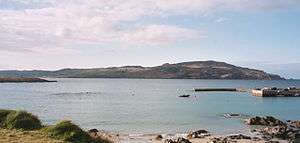Portnablagh
| Portnablagh Port na Bláiche | |
|---|---|
| Town | |
 Portnablagh Location in Ireland | |
| Coordinates: 55°10′41″N 7°55′57″W / 55.17813°N 7.93263°WCoordinates: 55°10′41″N 7°55′57″W / 55.17813°N 7.93263°W | |
| Country | Ireland |
| Province | Ulster |
| County | County Donegal |
| Time zone | WET (UTC+0) |
| • Summer (DST) | IST (WEST) (UTC-1) |
| Irish Grid Reference | C055307 |

Portnablagh (Irish: Port na Bláiche, meaning, depending on translation, either 'port of the flowers' or 'harbour of the buttermilk',[1] possibly from the rough seas in the area) is a small village in County Donegal, Ireland. Portnablagh (also written in English as Port-na-Blagh) is located on Donegal's North West coast, specifically the west side of Sheephaven Bay. It is on the N56 road.[2]
Portnablagh, along with neighbouring Dunfanaghy, is well known for its beaches and picturesque harbour. It attracts many tourists, mostly from Northern Ireland, every summer.
The small harbour is well protected on 3 sides and has a relatively short slipway which gets frequent use by fishing and pleasure boat owners, particularly during summer months. It provides access for boat owners to a large number of beaches in Sheephaven Bay, many of which are only accessible on foot or by sea.
Faugher House
On the south-eastern edge of Portnablagh, between Ards Forest Park and Portnablagh itself, lie the ruins of Faugher House, also known as O'Boyle's Castle or Wray's Castle.[3] This small fortified house and its surrounding bawn were built during the Plantation of Ulster, and may have been built in stages throughout the seventeenth-century.[4] The original 'castle' or fortified house on this site was probably built for Turlough Roe O'Boyle about 1611.[5][6] The surviving bawn on the site probably dates from this time, very early in the Plantation of Ulster.[7]
However, the surviving 'Plantation-era' fortified house (now ruined) may have been built in the second half of the seventeenth-century, possibly for the Wray family.[8][9] The building was probably abandoned by the mid-eighteenth-century.[10] The rather 'Scottish-style' ruin is beside 'the Middle Road', a sideroad leading to Breaghy Head, just off the N56, the main Letterkenny to Dunfanaghy road. The site is privately owned and is not open to the public.
See also
References
- ↑ Patrick McKay, A Dictionary of Ulster Place-Names, p. 121. The Institute of Irish Studies, The Queen's University of Belfast, Belfast, 1999.
- ↑ Untitled Page
- ↑ Brian Lacy (Editor), Archaeological Survey of County Donegal, pp. 367-369. Donegal County Council, Lifford, 1983.
- ↑ Brian Lacy (Editor), Archaeological Survey of County Donegal, p. 369. Donegal County Council, Lifford, 1983.
- ↑ Brian Lacy (Editor), Archaeological Survey of County Donegal, pp. 367-369. Donegal County Council, Lifford, 1983.
- ↑ Alistair Rowan, The Buildings of Ireland: North West Ulster (popularly known as the Pevsner Guide to North West Ulster), p. 124. Yale, London, 2003 (originally published by Penguin, London, 1979).
- ↑ Brian Lacy (Editor), Archaeological Survey of County Donegal, p. 369. Donegal County Council, Lifford, 1983.
- ↑ Brian Lacy (Editor), Archaeological Survey of County Donegal, p. 369. Donegal County Council, Lifford, 1983.
- ↑ Willie Cumming, Duncan McLaren and T.J. O'Meara, An Introduction to the Architectural Heritage of County Donegal, pp. 20-21. National Inventory of Architectural Heritage (N.I.A.H.), Department of Arts, Heritage and the Gaeltacht, Dublin, 2014.
- ↑ Willie Cumming, Duncan McLaren and T.J. O'Meara, An Introduction to the Architectural Heritage of County Donegal, pp. 20-21. National Inventory of Architectural Heritage (N.I.A.H.), Department of Arts, Heritage and the Gaeltacht, Dublin, 2014.
